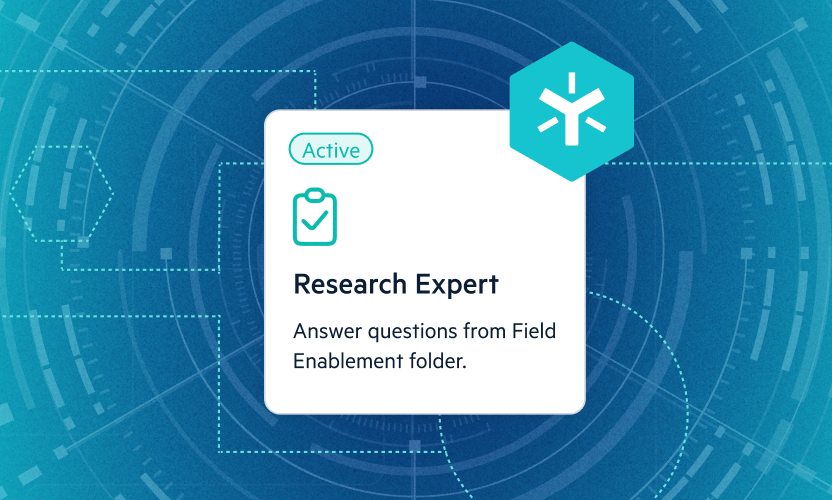
Rewriting the Rules of Financial Services Content Management
AI and automation hold massive potential, but they can’t come at the expense of trust and control.
That perspective, shared by Jerry Silva of IDC during our Financial Services Summit 2025 keynote, underscores a central tension in financial services: How do we adopt transformational technologies without undermining the very controls that define our industry?
For decades, firms have operated under a familiar set of rules about compliance, security, data management, and efficiency. But the conversations at this year’s summit made one thing clear: those rules are changing.
The summit provided a forum for financial leaders to share how they are challenging some of the industry's long-held rules in the new AI-driven world. Below, we've captured four main "rules" and how the financial leaders who presented are rewriting them to take control of their content, data, and operations.
Rule #1: Security Slows Things Down
Historically, financial firms treated security and compliance as necessary friction. Processes like access controls, encryption, audit trails, and policy enforcement were bolted on after workflows were built, making them slow, disruptive, and reactive. The more regulated the environment, the slower the processes.
What’s changed: Security can no longer exist in isolation. As Max Mejiborsky, Vice President of Compliance Services with COMPLY, explained, “Everyone is contributing content. Everyone is impacted by compliance.”
In Clearstead’s session, their leadership explained how firms are shifting from retroactive controls to embedded governance, where classification, permissions, and lifecycle rules are integrated into the daily flow of work.
The new rule: Security enables scale—when built into workflows. Mejiborsky captured the shift well in our session by discussing who owns governance within a firm: Firms no longer have the luxury of siloed ownership.
Clearstead discussed how they have seen this success firsthand with restructuring governance, not as a standalone initiative, but as a collaborative foundation that spans IT and compliance. By embedding policies at the system level—within the platforms people already use—security becomes invisible, intuitive, and scalable. The result: agility without compromise.
Rule #2: AI Replaces People and Exposes Data
During the mid-2010s, early AI experiments in financial services—like robo-advisors—focused on replacing human interaction. But these tools lacked nuance, context, and client trust. Clients, customers, and financial service partners still wanted to work with humans, especially when something didn’t go as planned.
Meanwhile, more recent generative AI tools often require uploading sensitive data into opaque third-party models, increasing compliance risk and limiting enterprise adoption.
What’s changed: We’ve shifted from generic AI to domain-aware AI. As Egnyte’s VP of Global Strategic Services, Mike Soldan, demonstrated in his session Inside Egnyte Copilot, firms are now deploying AI that doesn’t expose internal documents, is governed by firm-specific access controls, and is purpose-built for tasks that summarize investment memos, highlight contract anomalies, or compare regulatory disclosures. It’s not replacing judgment—it’s accelerating it.
The new rule: AI empowers people to work smarter and safer. By acting as a context-aware assistant, not a black box, AI improves decision quality, eliminates repetitive tasks, and keeps data under control. As Soldan put it: “This is your data, your context, your control.”
Rule #3: Compliance Is a Gatekeeper
In many firms, compliance historically functioned as the final hurdle in reviewing activity after the fact or before it moved to the next step, blocking risky behavior, or issuing mandates downstream of operational needs. This created friction between compliance and business units, often leading to workarounds or delays.
What’s changed: Firms are shifting from a model of compliance enforcement to compliance collaboration. In our fireside chat, Paul Dalton, Chief Technology Officer of tru Independence, explained how Egnyte helped unify workflows across RIAs, enabling compliance and advisors to work from a common system with shared visibility and controls. As Dalton put it, “We stopped trying to retrofit compliance. We started building it in from the beginning.”
The new rule: Compliance is a collaborator. When tru Independence needed to modernize how they onboarded clients across their network of RIAs, they weren’t just looking for a faster process—they needed one that satisfied both advisors and compliance.
When policies are built into workflows and the systems that support them, like Egnyte, DocuSign, and Advyzon, oversight becomes continuous, not reactive. This transforms compliance from a bottleneck into a business enabler.
Rule #4: Document Collection Is Inherently Messy
Client document intake has traditionally relied on email, spreadsheets, and file-share folders. A lack of standardization, automation, or visibility led to inconsistent formats, missing files, and manual validation steps across onboarding, underwriting, or audits.
What’s changed: Firms are embracing tools like document portals to structure intake from the start. As Rick Hill, Vice President of Industry Technology at Mortgage Bankers Association and Interim President of MISMO, shared, firms can now automate file collection and quality assurance with templates, permission controls, and AI-based validation.
The new rule: Structured intake is the new baseline, and clients expect it. Digitization alone isn’t enough. Repeatable, secure intake flows reduce risk, improve client experience, and set the stage for automation downstream.
Egnyte’s Document Portal, designed specifically to address this challenge, was featured as a solution that automates request creation from templates, evaluates file types and formats, and enforces permissions from the start. This standardization transforms how firms approach onboarding, loan origination, M&A, and audits, adding capacity to firms.
What This All Means
The message across all sessions, whether from tru Independence, Clearstead, Mortgage Bankers Association, or Egnyte’s product team, was consistent: Progress isn’t about adhering to the old rules better, it’s about using technology to create a whole new set of rules.
The financial firms poised to lead are those rethinking how their content and compliance ecosystems interact. They’re choosing integrated systems over fragmented ones. Embedded AI over black-box tools. Collaboration over departmental silos.
If you didn’t catch all the Financial Services Summit 2025 live sessions, I encourage you to explore the replays. You’ll hear real stories of transformation, grounded in practical insight.
Let’s keep rewriting the rules—together.






